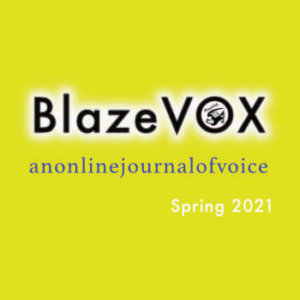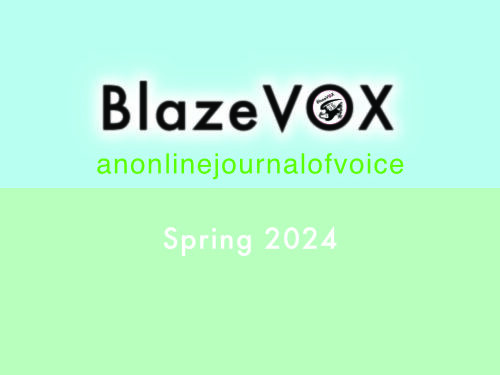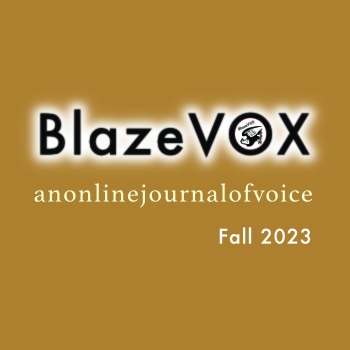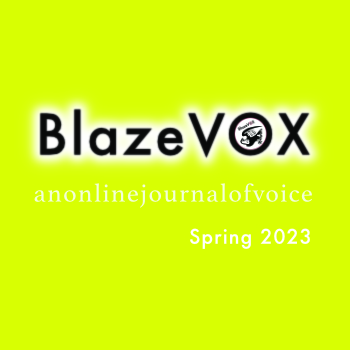IntroductionIntroduction
 Hello and welcome to the Spring 2021 issue of BlazeVOX! Presenting fine works of poetry, fiction, text art, visual poetry and arresting works of creative non-fiction written by authors from around world. Do have a look through the links below or browse through the whole issue in our Scribd embedded PDF, which you can download for free and take it with you anywhere on any device. Hurray!
Hello and welcome to the Spring 2021 issue of BlazeVOX! Presenting fine works of poetry, fiction, text art, visual poetry and arresting works of creative non-fiction written by authors from around world. Do have a look through the links below or browse through the whole issue in our Scribd embedded PDF, which you can download for free and take it with you anywhere on any device. Hurray!Rockets! Geoffrey Gatza, editor
Alex Clermont — Small Steps
Alexandra Persad — First Frost
Clement Joseph Haan — May
Gregory Kanhai — Purgation 24
Judith Goode — Around Robin Hood’s Barn
Niles Reddick — Elevator Ride
Ralph Bland — Wherefore
Ronald Fink — Tinnitus
Sarah M. Prindle — The Spear
Shambhavi Roy — Houseflies
William L. Alton — Get Better or Die
BlazeVOX21 Spring 21 by BlazeVOX [books] on Scribd
New & Forthcoming from BlazeVOX books
Orchid Tierney, author of Ocean Plastic: Andrew Brenza is an inventive visual architect of the English language. His collection Smearbrings to the fore a literal and figurative smudging of classification and sharply smashes the received assumptions of the naturalness of American political rhetoric. Whether it is in the manipulations of inaugural presidential speeches or the anagrammatic torqueing of Trumpian tweets, these visual poems mobilize the materiality of linguistic resistance and wit. I love the transmutability of his poetic language and the entrancing forms he generates. This collection is a bold delight!
The Thirteenth Studebaker by Robert Wexelblatt
Wexelblatt’s book is laden with wit, with wry observations, gentle sarcasm, and wicked ironies. It always has just enough laughter to keep its characters (and the reader) from spinning off into the abysses. Fred Marchant, review of Life in the Temperate Zone in Harvard Book Review
Poetic Realism by Rachel Blau DuPlessis
Poetic Realism by Rachel Blau DuPlessis is the fourth episode of the on-going work Traces, with Days. It is both a committed poetry looking out at the world in witness, resistance, and with a fervent vow to find “incantatory information” in an account of what is seen, felt, and thought. This is a responsive book, mixing the tiny person and the cosmos, entering a dialogue about the body politic, presenting commentary with a dissolve into uncertainty. She mixes the starkness of disaster with strange dreams of being and loss, and she negotiates inside the real with the tools of irreverence–and poetry. The book, deploying some odd genres, reveals DuPlessis’s characteristically serious wit and the challenge of her mix: “poetic realism.”
Robert Creeley on the Poet’s Work in conversation with and photographs by Bruce Jackson
This is an edited transcript of a conversation about the work poets do that Robert Creeley and Bruce Jackson held in Robert Creeley’s home—a converted firehouse in Buffalo’s Black Rock district— the morning of September 6, 2001. One of Bob’s favorite words was “company.” He was always talking about being part of a company—a company of family, of poets, of artists, of deep connections going anywhere in the world, of this group here on this night around this table, eating and drinking and talking, always talking.
Derrida’s In/Voice by Chris Tysh
There is immense talent here — Chris Tysh just gets better and better. With multiple registers and citational energy, the archive is exploded and transformed: we find references to poetry, film, revolution, politics, and philosophy, all effortlessly braided and made dynamic as they speak to one another. With perfectly pitched music, and impeccable form, Derrida’s In/Voice discloses and complicates the knotted conversation between hard and soft power. It’s an awesome book. — Peter Gizzi
POEMS: now and then by Edric Mesmer
These poems fall all too neatly into two sections, the eponymous “now” and “then.” I feel the “now” poems, all from the early months of 2020, share a returning-to with the “then” poems, some of which were written as long as 20 years ago. That they have come together so squarely—so circularly—(at least to me), speaks to a sympathy between then and now. I hope that the reader will also find this to be true.
—Edric Mesmer, May 2020
How Proust Ruined My Life & Other Essays by Gloria Frym
In this wonderful assemblage of essays, Gloria Frym liberates the act of reading from the confines of the page. She leads us into the open air where the personal and the public intersect and create a new avenue of possibilities: the book in the hand, the world outside your window. Especially memorable are the probing essays on Jean Toomer and Lorine Niedecker, and her homage to David Meltzer. How Proust Ruined My Life is a timeless book and deserves a wide audience. –Lewis Warsh
For Love (the order of the echoes) by Jared Schickling
How refreshing and enlightening to read a poet who is close reading another poet through the art of poetry (as opposed to commentary, its inverse). There is no greater homage to a great teacher than to take what he held most dear—assonance, sibilance, language, and love—and elevate it into a new consciousness: one that dives deeply into a great poet’s failures in order to reverberate his echoing prosody into new form. Like Creeley—who could turn an angel on a pin by writing tiny poems, or expand a field into a universe by drawing out long ones—Schickling’s poems eschew easy images by making metaphors move the mind into a composted groundlessness. Here, the particulars of daily life are the rich material which Schickling’s poems order into such eloquent echoes. —Kristin Prevallet
Two Dreams of the Afterlife by Kelly Bancroft
The poems in Kelly Bancroft’s Two Dreams of the Afterlife are wild and beautiful as they create worlds from the ordinary made strange, and from the strange made predictable. The materials are everyday objects and events, especially our unavoidable deep connection to figures of popular culture (the Six Million Dollar Man, Wonder Woman, Hal the computer, and John Boy Walton). —Maggie Anderson
Endless Spectator by The Screens Suite
Is it such an impossible idea to ascribe placehood to a typographic symbol? In the same way that half a dozen “picture elements” (aka “pixels”) convened at specific coordinates on a screen can indicate the end of a sequence of words in order to afford the reader’s mind a moment to digest what it just read, why can’t the period act as a linguistic watering hole for parched eyeballs?



Comments (0)